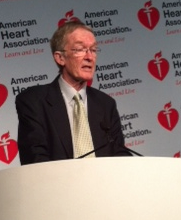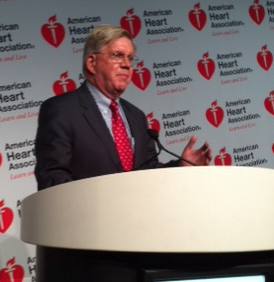November 16th, 2011
Experts Clash Over AIM-HIGH
Larry Husten, PHD
 Sparks flew at the AHA press conference yesterday when the designated discussant for the AIM-HIGH trial, Australia’s Philip Barter, said that “the design was such that in no way could it test the hypothesis” that niacin therapy may be beneficial. “This trial disturbs me greatly,” he said. The trial co-principal investigator, William Boden, defended his trial, but admitted that it was far from perfect.
Sparks flew at the AHA press conference yesterday when the designated discussant for the AIM-HIGH trial, Australia’s Philip Barter, said that “the design was such that in no way could it test the hypothesis” that niacin therapy may be beneficial. “This trial disturbs me greatly,” he said. The trial co-principal investigator, William Boden, defended his trial, but admitted that it was far from perfect.
Barter’s case began with the trial’s design, as it was only powered to detect a 25% reduction in cardiovascular events. However, although HDL levels in the trial increased by 25% with niacin, substantial increases in HDL were also observed in the placebo group, so that there was only a 4-mg/dL difference in HDL between the groups. In addition, LDL levels reached similar levels in the two groups (68 and 63 mg/dL in the placebo and niacin arms, respectively). According to Barter, these small differences between the groups would predict at best a 12.5% reduction in CV events, only half the amount for which the trial was powered.
“Given that this study has not tested the hypothesis, I do not believe our practice should change” because of its results, said Barter. He added that any decision about niacin should await the much larger HPS2-THRIVE study in a few years, as it is sufficiently powered to answer the question.
 Boden countered that the results of the trial ruled out a large benefit for niacin, and that the VA HIT trial with gemfibrozil had turned up a large clinical benefit associated with a small increase in HDL. Boden said there is no evidence to support the continued use of niacin in the statin era, though he stopped short of saying that the drug should no longer be used. He agreed with Barter that HPS2-THRIVE would provide a definitive answer about the utility of niacin.
Boden countered that the results of the trial ruled out a large benefit for niacin, and that the VA HIT trial with gemfibrozil had turned up a large clinical benefit associated with a small increase in HDL. Boden said there is no evidence to support the continued use of niacin in the statin era, though he stopped short of saying that the drug should no longer be used. He agreed with Barter that HPS2-THRIVE would provide a definitive answer about the utility of niacin.
AHA spokesperson Roger Blumenthal said that although there is no current evidence to support the use of niacin, it is reasonable to give it to patients who continue to have high LDL levels after maximal statin therapy. But for people with LDL levels in the 70s, he said, “it would be hard to justify.”
Commenting on the striking difference between Boden and Barter during the press conference, Elliott Antman, the AHA program chair, observed: “If ever you saw an example of clinical equipoise, this is it.”
